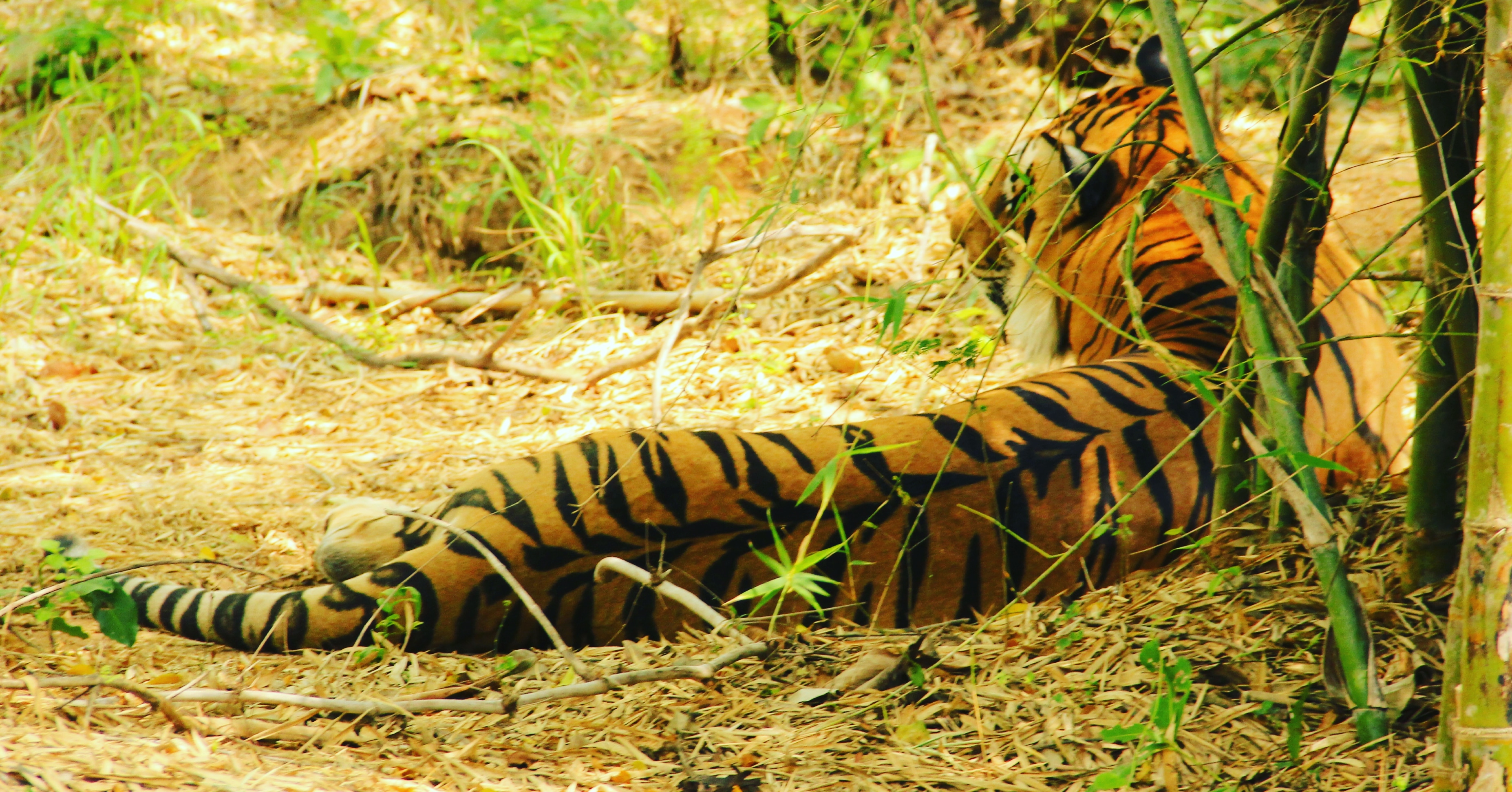November 18 is a red letter day for our national animal.
It was on this day in 1972, The Royal Bengal Tiger was conferred the title of National Animal. Panthera tigris as it named in Latin, has the combination of grace, strength, agility and enormous power earning its pride of place as the national animal of India.
The largest in cat family, it has eight sub-species – Royal Bengal, Indo-Chniese, Sumatran, Amur/Siberian, South China, Caspian, Java and Bali, with last 3 being extinct.
In 1972, when the Tiger was elevated to a national symbol, its population was ~1,827 (using pugmark method, which is not considered as reliable). Thirty-eight years later, in 2010, camera-trap method was utilised to conduct a nation-wide census, which recorded just 1,706 across India in an area of 72,800 sq.kms, setting off alarm bells – both for tiger’s numbers as well as the dwindling area (of ~20,000 sq.kms) in reserve forests.
In 2014, the National Tiger Conservation Authority declared that India’s tiger population had bounced to 2,226, from a low of 1,411 in 2006 when the entire tiger population in Rajasthan was wiped out; in South, the forests of Western ghats in Mudumalai, Bandipur, Nagarhole and Wayanad, have the world’s largest tiger population concentrated in a single region, estimated at ~570 tigers. India now has 70% of world’s tiger population. The extent of land area occupied by Tigers is estimated at less than 11,84,911 sq kms, consisting of both reserves and non-reserved areas.
 Tigers have ~100 black stripes, each one distinct, and no two tigers share a pattern – like a human thumb. Seen here – an adolescent at Bannerghatta National Park. (Photo from own collection)
Tigers have ~100 black stripes, each one distinct, and no two tigers share a pattern – like a human thumb. Seen here – an adolescent at Bannerghatta National Park. (Photo from own collection)
There is a 33% jump in numbers (latest count ~3,000 declared by PM Modi on World Tiger Day, July 30, 2019). 50 tiger reserves in 18 states account for 80% of world’s tiger population. The census, an extensive exercise is considered to be the world’s largest wildlife survey. It covered 381,000 sq. km of forested habitats in 18 states where tigers are found in India. A foot survey of 5.22 lakh km was done for tiger signs and prey abundance estimation. A total of 26,838 camera traps resulted in 34.8 million photographs of wildlife, of which 76,651 were of tigers and 51,777 of leopards (livemint.com). In about 2 waking days in the southern-wild, I have seen one pug mark… so deep are our jungles? Mowgli?
While the spurt is a cause for rejoicing, wild animals have to grapple for space not only amongst themselves but also with human greed. Diminishing forest areas including special reserves, due to encroachments (living and farming), transport (rail and road), and Govt grants not to mention poaching – resulting in increasing conflicts and loss of livestock, humans and hunted wild animals. MoEFF’s recent fast-tracking of projects for highways through forests, reducing eco-sensitive zones, green zones, reserve zones, allowing night travel in sensitive areas, etc., aren’t encouraging – however SC has put paid to these efforts by striking down few of the orders passed. Unequal area allocations, lack of proper vegetation in the forests, reduced feedstock in jungles, are also equal cause for concern. Climate change affects them as well – periodical flooding of Kaziranga has taken its toll on the animals within its forest, notably the single-horned Rhino. There are few ngo’s fighting for the cause of these wild ones, increasing awareness among public, and trying their hand in conservation – like cwsindia.org, wti.org.in, wcs.org, www.wpsi-india.org and of course, popular ones like wwfindia.org, bnhs.org, et al.
MoEFCC needs to step in, take cognizance of ground reality and formulate rules for proper administering their policies, empower the Forest dept personnel to fight with with poachers and timber gangs.
As an individual what can you and I do? Next time when travelling to a forest, to stay or a sighting / photography trip, please take care to be responsible – not throw waste, not to feed/leer/jeer/call or disturb any wild animal in its territory, especially not venture near the young ones, if you are lucky to find any. Never buy products related to or sourced out of wild animals, its not only illegal, its unethical. Identify a known organisation and support their cause in wildlife conservation, not necessarily by donating funds. Report an abuse or trade to the nearest police-station / conservator of forests. One Veerappan (dreaded poacher of Western ghats) eliminated will not save the world’s wild!
- Some astonishing, fun-facts:
- Tigers grow upto 3.3 mtrs, weigh 300 kgs, and can jump upto 6 mtrs height
- Unlike cats, they like to play in water and are good swimmers
- Tiger cubs are born with all the stripes, and the cutesies are very vulnerable, taking upto 2 weeks to see properly (they’re actually blind)
- Though in 2 months they stop milk and can eat meat, cubs rely on their mother to provide food until around 2 years, while picking up instinctive tricks to hunt/kill
- Half the cubs born survive beyond 2 years of age, when they move away from their parent, and if they do manage, live for 25 years
- Not known to be the swiftest, they can still run at 60 kmph!
- Tigers, though ferocious, are humble beings, hardly roaring unlike Lions
- Chivalrous males allow their female mate and her cubs to eat first (ironically can kill cubs just to mate with a female) and sometimes, re-hunt for themselves
- Just 10% of their hunting efforts are successful.
- A group of Tigers is called an ambush, even if its just a mum with kid.
- Its said that many tigers are in captivity as there are in the wild (I haven’t counted!)
- A mix of Tigers and lions are called Liger or Tions, whichever appears obvious – many exist in USA, Czech Republic, China, Iran, Russia, India (?), UAE and Argentina (not just in NatGeo TV channel)
- A paw swipe can crack a bear’s skull or its back, you’d never want to be on its side
Tigers are graceful, solitary creatures, and just let them be – Our National Icon!
